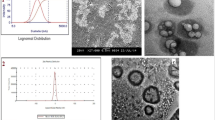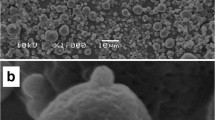Abstract
Cerebrolysin is a peptide mixture able to ameliorate symptomatology and delay progression of neurological disorders such as Alzheimer’s disease and dementia. The administration of this drug in humans presents several criticisms due to its short half-life, poor stability, and high doses needed to achieve the effect. This paper investigates the potential of polylactic-co-glycolide (PLGA) nanoparticles (NPs) as sustained release systems for iv administration of cerebrolysin in normal and brain injured rats. NPs were prepared by water-in-oil-in-water (w/o/w) double emulsion technique and characterized by light scattering for mean size and zeta potential and by scanning electron microscopy (SEM) for surface morphology. The NPs produced by double sonication under cooling at 60 W for 45 s, 12 mL of 1 % w:v of PVA, and 1:0.6 w:w drug/PLGA ratio (C-NPs4) displayed an adequate loading of drug (24 ± 1 mg/100 mg of NPs), zeta potential value (−13 mV), and average diameters (ranged from 250 to 330 nm) suitable to iv administration. SEM images suggested that cerebrolysin was molecularly dispersed into matricial systems and partially adhered to the NP surface. A biphasic release with an initial burst effect followed by sustained release over 24 h was observed. Long-term stability both at room and at low temperature of freeze-dried NPs was investigated. To gain deeper insight into NP stability after in vivo administration, the stability of the best NP formulation was also tested in serum. These PLGA NPs loaded with cerebrolysin were able to reduce brain pathology following traumatic brain injury. However, the size, the polydispersivity, and the surface properties of sample were significantly affected by the incubation time and the serum concentration.








Similar content being viewed by others
References
Ruozi B, Belletti D, Bondioli L, De Vita A, Forni F, Vandelli MA, Tosi G (2012) Neurotrophic factors and neurodegenerative diseases: a delivery issue. Int Rev Neurobiol 102:207–247
Sharma HS, Johanson CE (2007) Intracerebroventricularly administered neurotrophins attenuate blood–cerebrospinal fluid barrier breakdown and brain pathology following whole-body hyperthermia an experimental study in the rat using biochemical and morphological approaches. Ann NY Acad Sci 1122:112–129
Sharma HS, Zimmermann-Meinzingen S, Johanson CE (2010) Cerebrolysin reduces blood-cerebrospinal fluid barrier permeability change, brain pathology, and functional deficits following traumatic brain injury in the rat. Ann NY Acad Sci 1199:125–137
Sharma HS, Zimmermann-Meinzingen S, Johanson CE (2010) Cerebrolysin attenuates blood-brain barrier and brain pathology following whole body hyperthermia in the rat. Acta Neurochir Suppl 106:321–325
Hartbauer M, Hutter-Paier B, Skofitsch G, Windisch M (2001) Antiapoptotic effects of the peptidergic drug cerebrolysin on primary cultures of embryonic chick cortical neurons. J Neural Transm 108:459–473
Feczkó T, Toth J, Dosa G, Gyensis J (2011) Optimization of protein encapsulation in PLGA nanoparticles. Chem Eng Process 50:757–765
Costantino L, Gandolfi F, Tosi G, Rivasi F, Vandelli MA, Forni F (2005) Peptide-derivatized biodegradable nanoparticles able to cross the blood brain barrier. J Control Release 108:84–96
Tosi G, Vergoni AV, Ruozi B, Bondioli L, Badiali L, Rivasi F, Costantino L, Forni F, Vandelli MA (2010) Sialic-acid and glycopeptides conjugated PLGA nanoparticles for central nervous system targeting: in vivo pharmacological evidence and biodistribution. J Control Release 145:49–57
Tosi G, Badiali L, Ruozi B, Vergoni AV, Bondioli L, Ferrari A, Rivasi F, Forni F, Vandelli MA (2012) Can Leptin-derived sequence-modified nanoparticles be suitable tools for brain delivery? Nanomedicine 7:365–382
Zhang Y, Chan HF, Leong KW (2013) Advanced materials and processing for drug delivery: the past and the future. Adv Drug Deliv Rev 65:104–120
Naahidi S, Jafari M, Edalat F, Raymond K, Khademhosseini A, Chen P (2013) Biocompatibility of engineered nanoparticles for drug delivery. J Control Release 166:182–194
Sharma HS (2010) Selected combination of neurotrophins potentiate neuroprotection and functional recovery following spinal cord injury in the rat. Acta Neurochir Suppl 106:295–300
Dey PK, Sharma HS (1983) Ambient temperature and development of traumatic brain oedema in anaesthetized animals. Indian J Med Res 77:554–563
Mohanty S, Dey PK, Sharma HS, Singh S, Chansouria JP, Olsson Y (1989) Role of histamine in traumatic brain edema. An experimental study in the rat. J Neurol Sci 90:87–97
Sharma HS, Wiklund L, Badgaiyan RD, Mohanty S, Alm P (2006) Intracerebral administration of neuronal nitric oxide synthase antiserum attenuates traumatic brain injury-induced blood-brain barrier permeability, brain edema formation, and sensory motor disturbances in the rat. Acta Neurochir Suppl 96:288–294
Sharma HS (2004) Influence of serotonin on the blood-brain and blood-spinal cord barriers. In: Sharma HS, Westman J (eds) The blood-spinal cord and brain barriers in health and disease. Elsevier Academic Press, San Diego, pp 117–158
Liu W, Leng H, Zhu Z, Chen G (2001) Analysis of the content of ten kinds of metal elements in cerebrolysin by atomic absorption spectrophotometry. Guang Pu Xue Yu Guang Pu Fen Xi 21:397–399
Gromova OA, Kudrin AV, Kataev SI, Mazina SS, Volkov A (2003) Effects of cerebrolysin on trace element homeostasis in the brain. Zh Nevrol Psikhiatr Im SS Korsakova 103:59–61
Bodmeier R, McGinity RW (1987) The preparation and evaluation of drug containing poly(dl-lactide) microspheres formed by the solvent evaporation method. Pharm Res 4:465–471
Rosca ID, Watari F, Uo M (2004) Microparticle formation and its mechanism in single and double emulsion solvent evaporation. J Control Release 99:271–280
Belletti D, Tosi G, Forni F, Gamberini MC, Baraldi C, Vandelli MA, Ruozi B (2012) Chemico-physical investigation of tenofovir loaded polymeric nanoparticles. Int J Pharm 436:753–763
Heurtault B, Saulnier P, Pech B, Proust JE, Benoit JP (2003) Physico-chemical stability of colloidal lipid particles. Biomaterials 24:4283–4300
Dobson J (2006) Gene therapy progress and prospects: magnetic nanoparticle-based gene delivery. Gene Ther 13:283–287
Sharma HS, Sharma A, Mössler H, Muresanu DF (2012) Neuroprotective effects of cerebrolysin, a combination of different active fragments of neurotrophic factors and peptides on the whole body hyperthermia-induced neurotoxicity: modulatory roles of co-morbidity factors and nanoparticle intoxication. Int Rev Neurobiol 102:249–276
Ruozi B, Belletti D, Forni F, Sharma A, Muresanu DF, Mossler H, Vandelli MA, Tosi G, Sharma HS (2014) Poly (D, L-lactide-co-glycolide) nanoparticles loaded with cerebrolysin display neuroprotective activity in a rat model of concussive head injury. CNS Neurol Disord Drug Targets 13:1475–1482
Sharma HS, Menon PK, Lafuente JV, Aguilar ZP, Wang YA, Muresanu DF, Mössler H, Patnaik R, Sharma A (2014) The role of functionalized magnetic iron oxide nanoparticles in the central nervous system injury and repair: new potentials for neuroprotection with cerebrolysin therapy. J Nanosci Nanotechnol 14:577–595
Sharma A, Muresanu DF, Mössler H, Sharma HS (2012) Superior neuroprotective effects of cerebrolysin in nanoparticle-induced exacerbation of hyperthermia-induced brain pathology. CNS Neurol Disord Drug Targets 11:7–25
Sharma HS, Dey PK (1986) Influence of long-term immobilization stress on regional blood-brain barrier permeability, cerebral blood flow and 5-HT level in conscious normotensive young rats. J Neurol Sci 72:61–76
Sharma HS, Dey PK (1986) Probable involvement of 5-hydroxytryptamine in increased permeability of blood-brain barrier under heat stress in young rats. Neuropharmacology 25:161–167
Sharma HS, Dey PK (1987) Influence of long-term acute heat exposure on regional blood-brain barrier permeability, cerebral blood flow and 5-HT level in conscious normotensive young rats. Brain Res 424:153–162
Sharma HS (1987) Effect of captopril (a converting enzyme inhibitor) on blood-brain barrier permeability and cerebral blood flow in normotensive rats. Neuropharmacology 26:85–92
Sharma HS, Olsson Y (1990) Edema formation and cellular alterations following spinal cord injury in the rat and their modification with p-chlorophenylalanine. Acta Neuropathol 79:604–610
Sharma HS (2007) Methods to produce hyperthermia-induced brain dysfunction. Prog Brain Res 162:173–199
Sharma HS, Olsson Y, Persson S, Nyberg F (1995) Trauma-induced opening of the blood-spinal cord barrier is reduced by indomethacin, an inhibitor of prostaglandin biosynthesis. Experimental observations in the rat using [131I]-sodium, Evans blue and lanthanum as tracers. Restor Neurol Neurosci 7:207–215
Joshi DP, Lan-Chun-Fung YL, Pritchard JG (1979) Determination of poly (vinyl alcohol) via its complex with boric acid and iodine. Anal Chim Acta 104:153–160
Biswal I, Dinda A, Das D, Si S, Chowdary KA (2011) Encapsulation protocol for highly hydrophilic drug using non biodegradable polymer. Int J Pharm Pharm Sci 3:256–259
Abdelwahed W, Degobert G, Stainmesse S, Fessi H (2006) Freeze-drying of nanoparticles: formulation, process and storage considerations. Adv Drug Deliv Rev 58:1688–1713
Menon JU, Kona S, Wadajkar AS, Desai F, Vadla A, Nguyen KT (2012) Effects of surfactants on the properties of PLGA nanoparticles. J Biomed Mater Res A 100:1998–2005
Elliott KA, Jasper HH (1949) Measurement of experimentally induced brain swelling and shrinkage. Am J Physiol 157:122–129
Katas H, Hussain Z, Awang SA (2013) Bovine serum albumin-loaded chitosan/dextran nanoparticles: preparation and evaluation of ex vivo colloidal stability in serum. J Nanomater. doi:10.1155/2013/536291
Acknowledgments
This investigation is supported in part by grants from the Air Force Office of Scientific Research (EOARD, London, UK), and Air Force Material Command, USAF, under grant number FA8655-05-1-3065; Swedish Medical Research Council (Nr 2710-HSS), Swedish Strategic Research Foundation, Stockholm, Sweden; Göran Gustafsson Foundation, Stockholm, Sweden (HSS), Astra Zeneca, Mölndal, Sweden (HSS/AS), The University Grants Commission, New Delhi, India (HSS/AS), Ministry of Science and Technology, Govt. of India and Govt. of Sweden (HSS/AS), Indian Medical Research Council, New Delhi, India (HSS/AS); and India-EU Research Co-operation Program (AS/HSS).
Author information
Authors and Affiliations
Corresponding author
Rights and permissions
About this article
Cite this article
Ruozi, B., Belletti, D., Sharma, H.S. et al. PLGA Nanoparticles Loaded Cerebrolysin: Studies on Their Preparation and Investigation of the Effect of Storage and Serum Stability with Reference to Traumatic Brain Injury. Mol Neurobiol 52, 899–912 (2015). https://doi.org/10.1007/s12035-015-9235-x
Published:
Issue Date:
DOI: https://doi.org/10.1007/s12035-015-9235-x




